In the vast world of reptiles, there’s a mind-boggling array of lizards – think over 6,500 species! Crazy, right? Among this crowd, many types of iguanas are kind of rockstars. But, beyond just knowing their name, there’s so much more to learn about these cool critters.
The term “iguana” is not just a cool word to say, but it represents one of the most iconic groups of lizards out there. Originating from the Taino word “iwana,” the name “iguana” encompasses two iguana species: the green iguana and the lesser Antillean iguana. But here’s where it gets interesting – often, folks use “iguana” to refer to other members in the iguana family, even though they’re not technically iguanas. These critters are primarily herbivores and have this awesome ability to whip their tails when threatened. So, while “iguana” might conjure an image of that typical green lizard chilling in the sun, there’s a rich tapestry of species and traits hidden behind that name.
Before you read on we wanted to put a smile on you face and included this funny video of 5 iguanas below. Check it out!
Ready to dive a bit deeper and explore types of iguanas? Let’s go on this mini adventure together!
Table of Contents
Green Iguana

Have you ever met the Green Iguana (Iguana iguana)? Well, it’s the sensation of the reptile world. From the dense canopies of Central and South America, this radiant reptile has dazzled enthusiasts worldwide. Their colorful charisma isn’t the only thing that’s turned heads; their vibrant personalities do the trick too!
What Do They Look Like?
- Size Talks: These aren’t petite, hand-held pets; they’ve got some stretch. Adult iguanas, especially the fellas, can span anywhere between 5 to 7 feet.
- Signature Features: Length aside, these iguanas rock some cool dorsal spines, starting from their neck and running to their tail-tip. And that flashy flap under their chin, the dewlap? It’s essential for regulating body temperature and some good ol’ mating displays.
- Color Palette: Named after their striking green appearance, these iguanas have a spectrum up their sleeves. Their shade might shift based on age, health, or even their mood. As they age, don’t be thrown off if they rock shades from tangerine to deeper blues.
What’s on Their Menu and How Do They Roll?
Might look a tad menacing, but they aren’t into meat as much as you’d think. Green Iguanas lean heavily vegetarian. They fancy flowers, leaves, and fruits primarily. When it comes to their daily routine, these lizards are all about that arboreal life. High up in trees soaking rays or making a splash in water to cool off is their jam.
Thinking of Getting One? Here’s the Scoop
Thumbs Up:
- A visual treat that can jazz up conversations.
- You won’t deal with the fuss of live feed thanks to their plant-based diet.
- Invest time and care, and you might just become their favorite human.
Hmm, Consider This:
- Their expansive size means they need roomy homes.
- Got a mood, especially during the mate-y times.
- Ensuring they’re healthy isn’t a one-time gig; regular vet checks are crucial.
Parting Thoughts
Contemplating if the Green Iguana fits into your life? It’s all about the effort you’re ready to put in. They’re undoubtedly mesmerizing, but they’ve got needs. If your space, time, and affection quotas match up, jump in! But if you’re on the fence, perhaps admiring from a distance or in places that cater to their every whim is best.
Lesser Antillean Iguana
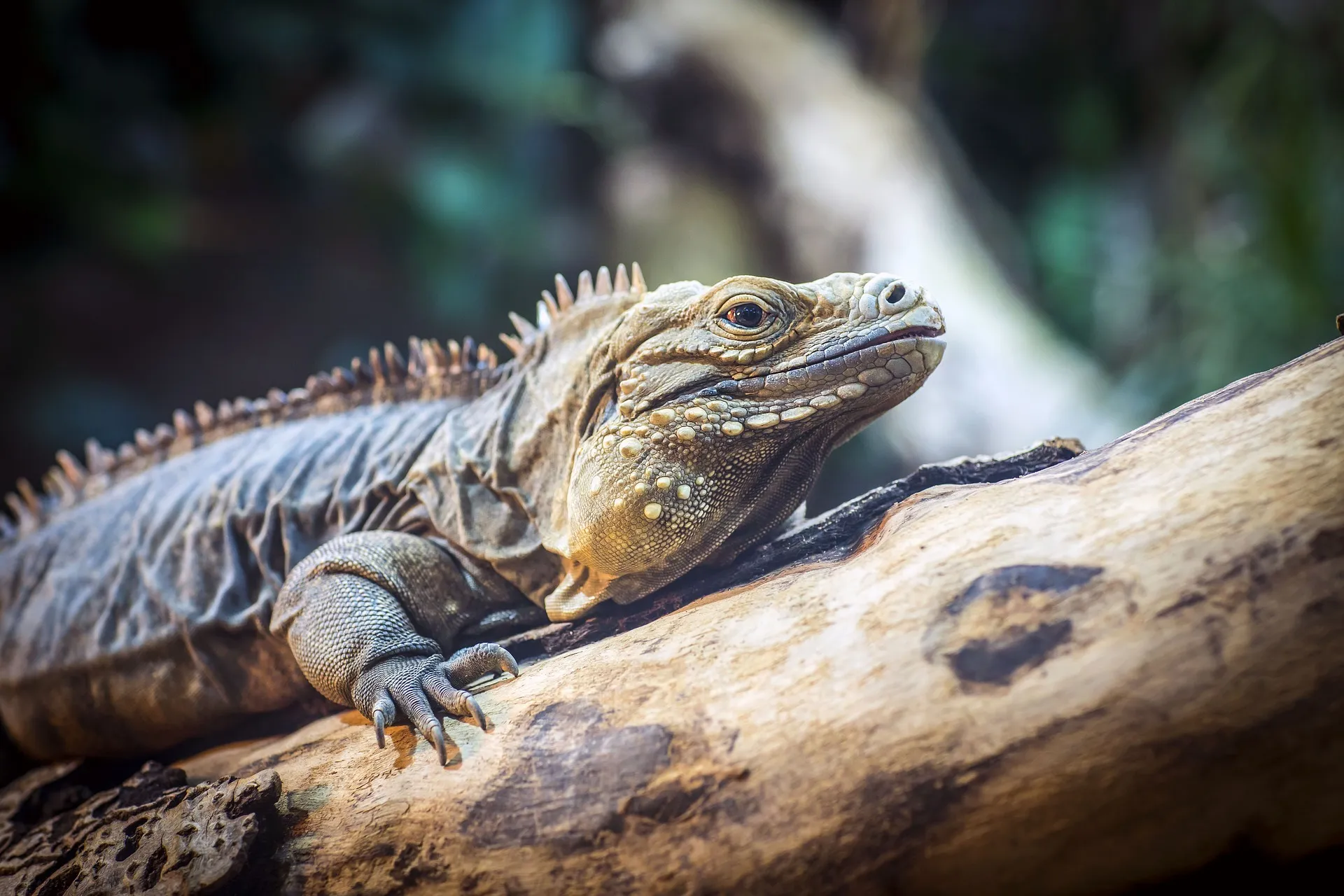
Ever had a rendezvous with the Lesser Antillean Iguana (Iguana delicatissima)? If not, you’re in for a treat! These sun-soaked stars hail from the idyllic shores of the Caribbean. Not only do they stand out with their vibrant visuals, but they’re also brimming with a kind of islander charm that’s hard to resist.
Breaking Down the Looks
- Size Matters: Compact yet compelling. These aren’t your massive reptilian beasts; they usually range between 16 to 24 inches. And guys, once again, generally edge out in the size department.
- Hallmark Traits: They’re not just smaller; they’re also trendsetters in their own right. Check out that iconic dorsal crest, giving them an air of the ancients. And those subtle folds beneath their neck? Those aren’t just fashion statements; they’re crucial for body temperature tweaks and some special “look-at-me” moments during mating season.
- Color Chronicles: These iguanas wear the Caribbean on their skin. A tantalizing mix of blues and greens mainly, they’re the epitome of tropical aesthetics. As they age, anticipate shifts in their shades, adding to their already magnetic allure.
Diet and Daily Beats
Don’t let their fierce facades fool you. These islanders are strict veggie lovers. From lush leaves to tropical fruits and the occasional flower treat, their palate is all green. On a typical sun-kissed day, they’re tree-huggers, literally. High branches, warm sunbeams, and perhaps a dip in the cool Caribbean are all part of their playbook.
Dreaming of an Iguana Buddy? Here’s the Lowdown
The Perks:
- An absolute visual joy, they’re bound to be your living room’s highlight.
- Dietary needs are simple and green, meaning no creepy crawlies for feed.
- With genuine care, you might just earn a spot in their good books.
The Flip Side:
- Their specific habitat needs can’t be compromised.
- They have their mood swings, especially when love is in the air.
- Like all pets, their health and well-being need consistent attention.
Leaving You with This
Wondering if the Lesser Antillean Iguana is your next best friend? Here’s the deal: they’re remarkable, no two ways about it. But they come with their unique set of needs. If you can resonate with the Caribbean vibes and have the resources to provide for them, why wait? If not, maybe just cheering for them from the sidelines, ensuring their conservation, is the way to go.
Central Fijian Banded Iguana

Ever heard whispers of the Fiji Banded Iguana (Brachylophus bulabula)? This gem shines bright amidst the myriad of reptilian wonders. Hailing from the mystical forests and shores of Fiji, this stunner is more than just its looks. Sure, they’re eye-catchy, but there’s a magnetic charm and an intriguing aura surrounding them that’s equally captivating.
How Do They Stand Out?
- Size Matters: Now, these are more on the compact side, but what they lack in size, they make up for in elegance. Typically, you’re looking at a length that varies between 8 to 12 inches, with the gents often being a smidge more imposing.
- Defining Traits: Their slender frame is adorned with these charismatic bands, setting them apart from their iguana cousins. And those dewlaps, though not as pronounced as some, are their own kind of chic, playing a part in their unique dance of communication and thermoregulation.
- Tinted Tales: While their name gives away the primary aesthetic of banded patterns, the blend of bright blues and greens makes them a literal embodiment of tropical paradise. It’s like they wear the Fijian seas and forests on their scales.
What Ticks Their Culinary Clocks?
Though they might seem like they’d snack on anything, they’re surprisingly discerning. Fiji Banded Iguanas are mainly herbivorous, with a keen preference for tender leaves, blossoms, and occasional fruits. As for their daily hustle? These creatures are the epitome of island vibes – basking under the sun, climbing trees, or taking swift, graceful dives when the mood strikes.
Mulling Over Making One Your Buddy? Here’s the Drill
The Upsides:
- They’re the kind of showstoppers that can light up any room or conversation.
- Their diet is fuss-free and plant-based; no wriggly worms to deal with.
- Given patience and understanding, they can grow fond of their human companions.
Some
- Being exotic, they need specific habitats that closely mimic their native homes.
- They have their temperamental days, especially when romance is in the air.
- Their well-being is a continuous commitment; routine check-ups and understanding are key.
A Few Final Words
Pondering about letting a Fiji Banded Iguana grace your life? It’s all about how far you’re willing to walk that extra mile for them. While they’re undeniably enchanting, these creatures have distinct needs and desires. If your lifestyle, resources, and empathy align, why not dive in? But if there’s any uncertainty, maybe it’s best to appreciate these island celebrities from a bit of a distance. After all, they’re not just pets; they’re ambassadors of a serene island realm.
Marine Iguana
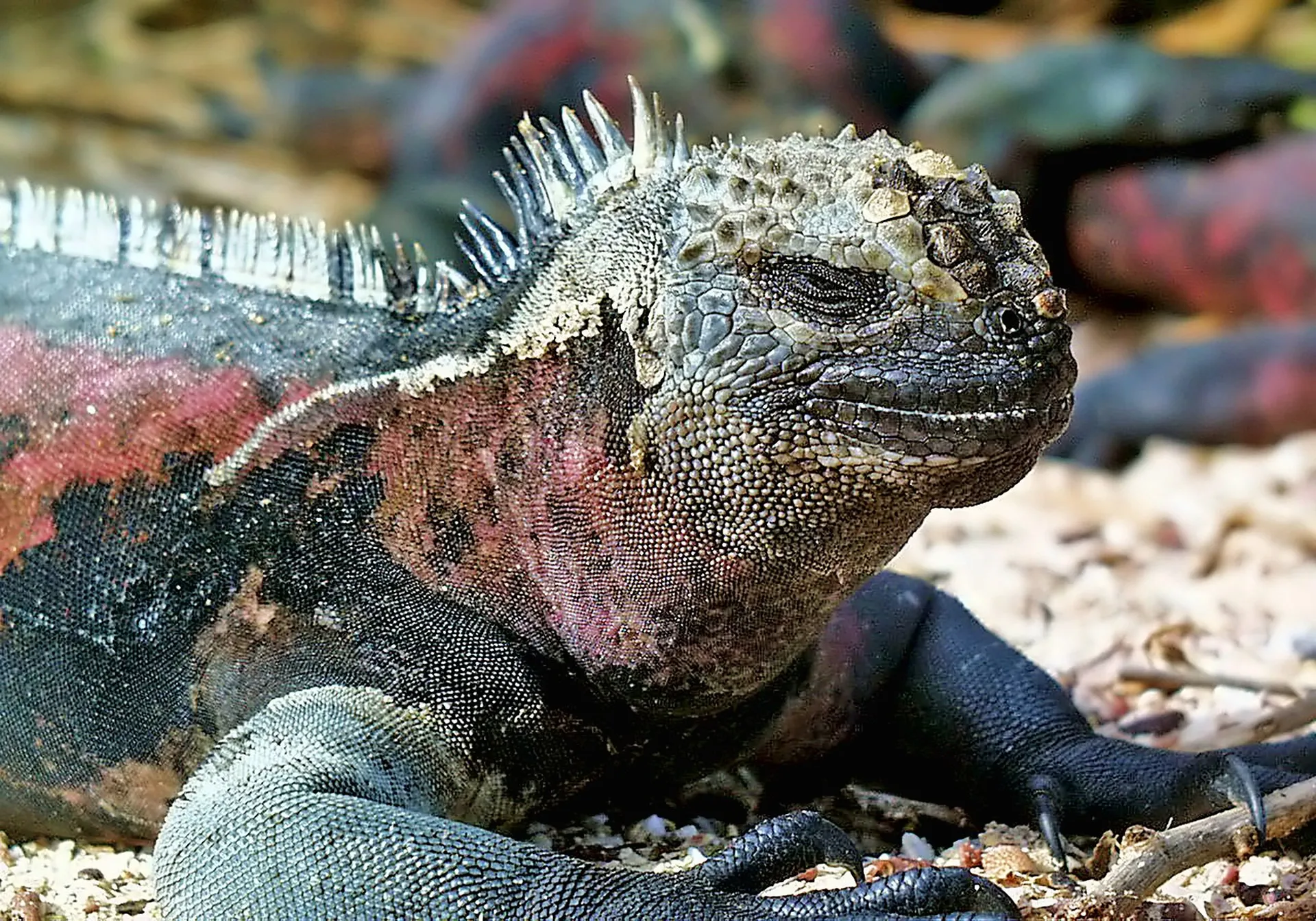
Ever met with the Marine Iguana (Amblyrhynchus cristatus)? This guy is the surf legend of the reptile kingdom. From the mystical shores of the Galápagos Islands, this ocean-going creature has left many spellbound. Their aqua-adventures are just one side of the coin; their unique aura is what makes the real splash!
How Do They Flaunt Their Features?
- Size Matters: While they’re not going to rival some of the giants in the reptile world, these critters have a decent size to them. Depending on their turf, adult ones can be between 2 to 5 feet, with the gents usually showing a bit more bulk.
- Unique Bits and Bobs: Now, these aren’t your garden-variety lizards. Designed for the waves, they sport a flattened tail that screams ‘pro swimmer’ and claws that are all about grip on those slippery volcanic rocks. And those rough, spiky scales? They’re a testament to their rugged, oceanic life.
- Shades of the Sea: Though primarily dark – a mix of charcoal and slate – these lizards have a trick up their sleeve. When the breeding season hits, some males take on colors that can only be described as sunset on water – think turquoise, crimson, and gold.
Diet Diaries and Daily Dives
Contrary to what their fierce look might suggest, these dudes aren’t hunting down their fellow marine life. They’re hardcore herbivores, with a penchant for underwater algae and seaweed. Most days, you’d find them sunbathing on rocks, recharging, or taking a deep dive for a seaweed snack.
Considering Sharing Surf with One? Here’s the Lowdown
On the Upside:
- Their unique marine adaptation is a conversation goldmine.
- Their vegetarian underwater menu means you’re not dealing with creepy crawlies for
food . - They’ve got this calm, contemplative aura that’s strangely soothing.
A Few Caveats:
- They’re wild, and replicating the Galápagos environment is a tall order.
- They do have their own ‘tides’ of mood, especially during the breeding times.
- They’re an endangered lot, so every individual counts, and their health is paramount.
Waves of Wisdom
Wondering if a Marine Iguana can be your next dive buddy? It’s all about syncing waves. They’re a marvel of evolution and adaptability, but they need the ocean, sun, and freedom. If you’re aligned with their needs and ready to ride the wave, you’re in for an adventure! But if you feel the tides pulling away, maybe just being an admirer during your next Galápagos trip is the way to go.
Rhinoceros Iguana

Ever bumped into the Rhinoceros Iguana (Cyclura cornuta)? This bad boy is like the unsung hero of the reptile realm. Hailing from the rocky terrains of the Caribbean, this robust reptile has left an indelible mark on many nature aficionados. And while their striking appearance is a showstopper, it’s their deep-rooted character that truly stands out.
Got Looks? They Sure Do!
- Size Matters: If you’re thinking dainty, think again. Rhinoceros Iguanas bring some serious presence. On average, adults, especially the gents, range from 2 to 4.5 feet.
- Trademark Traits: Apart from their considerable size, what’s that on their nose? A horn-like outgrowth, giving them that ‘rhino’ tag. This feature, combined with their rugged skin, makes them look like they’ve walked straight out of prehistory.
- Shades of Earth: Predominantly gray to brown, their skin texture and color seem like an ode to the rocky habitats they love. Their earthy tones are both a camouflage and a symbol of their hardy nature.
What’s Their Flavor?
Might seem like they’d munch on anything that moves, but you’d be mistaken. They’re primarily herbivores. Leaves, fruits, and flowers? That’s their jam. As for their day-to-day? You’d often spot them sunning on rocky terrains or digging in the ground, always keeping things grounded.
Fancy Co-existing with One? Here’s the Drill
The Bright Side:
- Their distinct appearance is bound to be a talking point.
- They’re not demanding when it comes to
food – plant matter is their go-to. - With dedication, you might just earn a nod (or a slow blink) of approval from them.
Things to Mull Over:
- They’re big, so a spacious environment is non-negotiable.
- They have their moments, especially during those testosterone-filled days.
- Regular health check-ups? Absolutely essential.
Some Parting Wisdom
Pondering if the Rhinoceros Iguana is the reptilian companion for you? It boils down to your readiness to commit. They’re a sight to behold and are filled with ancient wisdom (well, almost). If you’ve got the space and the patience, why not? But if you’re second-guessing, maybe just be an admirer; they sure are worthy of it.
Desert Iguana
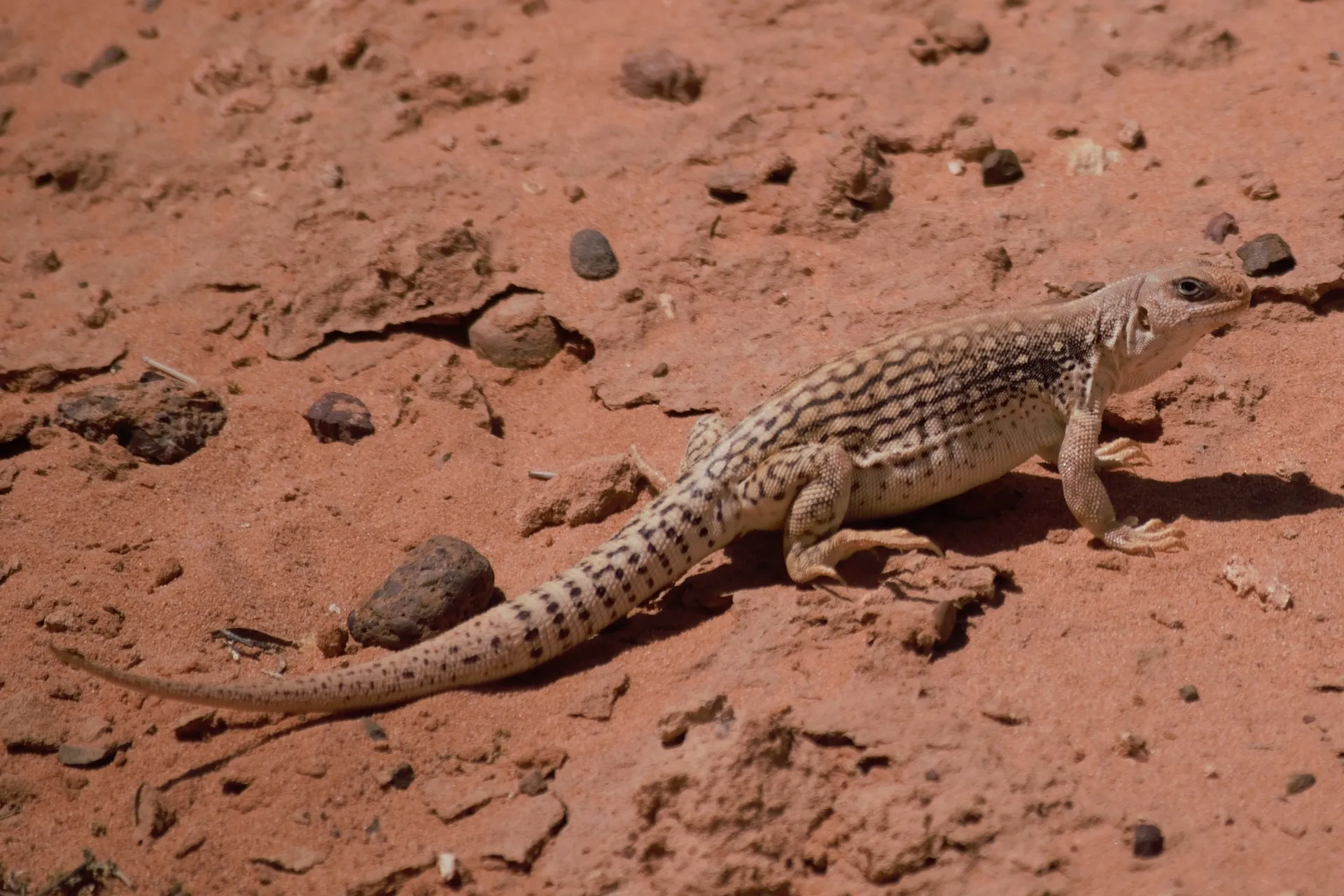
Ever stumbled upon the Desert Iguana (Dipsosaurus dorsalis)? This beauty is an emblem of dry regions. Making its home in the toasty corners of the American Southwest, this dune dweller has won over many an enthusiast. Beyond their uniquely desert-inspired looks, their fierce resilience in harsh conditions truly stands out.
What’s Their Vibe?
- Keeping It Compact: They won’t be the ones taking over your living area; they like to keep things snug. Grown ones measure between 10 to 16 inches – a lot of that length’s in the tail.
- Signature Style: Their design is all about efficiency for their sandy homes. You won’t see attention-grabbing spikes, but they’ve got a design that’s all about speed. That bit of extra skin around their neck? It’s not just a fashion statement but a cool adaptation for temperature control.
- Desert Tones: Their shades? Think desert morning. A mix of soft whites, earthen browns, and the occasional hint of rose, making them nearly invisible against their grainy backdrop.
What’s on Their Plate? And Their Usual Day Like?
Though they look tough, their diet’s pretty green. They have a weakness for all things planty. Blooms of the desert, succulent fruits, and tasty leaves? Those are their top picks. As for a day in their life? It’s about lounging under the sun, digging a cozy spot in the cooler sand, and playing the best game of desert camouflage.
Thinking of Bringing One Home? Here’s the Lowdown
Pros:
- Their unique appearance is a definite conversation starter.
- Their vegetarian habits make mealtime a breeze.
- Hailing from the desert, they’re sturdy and self-reliant.
A Few Notes:
- They thrive in warmth, so a desert-esque ambiance is essential.
- They value their space, and might get a bit touchy if they’re overwhelmed.
- Keep an eye on their health to ensure they’re thriving.
Parting Thoughts
Eyeing the Desert Iguana as a potential housemate? It boils down to how well you can emulate their natural habitat. They’re a window into the marvels of desert existence – both its beauty and tenacity.
Black Spiny-tailed Iguana

Stumbled upon the Black Spiny-tailed Iguana (Ctenosaura similis) yet? This beast is making waves in the reptile scene. Hailing from the tropical stretches of Central America, this dark-hued dynamo has left enthusiasts starstruck. Beyond their striking color, it’s their unique attitude that seals the deal!
Their Striking Appearance, Maybe?
- Size Matters: Think medium-to-large, these aren’t your pocket-sized companions. Many of these dark wonders, especially the boys, can grow between 3 to 4 feet.
- Key Features: Don’t expect the usual. These iguanas sport rugged dorsal spines which dash down from their nape to the tail’s end. Notice the flappy bit beneath their jawline? It’s not just for fashion – it aids in thermoregulation and those spicy mating signals.
- Color Code: These creatures are aptly named for their predominant black hue, but there’s more. Depending on factors like mood, health, or age, you might spot shades ranging from dusty grey to deep charcoal.
Feeding Habits and Daily Hustle
Intimidating at a glance, but surprise, surprise! Black Spiny-tailed Iguanas are quite fond of their veggies. Yes, they relish a mix of leaves, flowers, and fruits. Their typical day? Either basking under the sun, showing off their sleek scales, or maybe just lounging in shaded spots, mastering the art of chill.
Thinking About Adopting One? Here’s What You Need to Know
Pros:
- A definite head-turner that’ll spruce up any conversation.
- No bug-chasing; their love for greens makes feeding simple.
- Dedicate love and attention, and you might just land a spot in their good books.
A Few Heads-ups:
- Given their size, a spacious dwelling is non-negotiable.
- They can have their moods, especially when they’re feeling all romantic.
- Just like us, routine health checks are a must to keep them thriving.
Final Words
Pondering if the Black Spiny-tailed Iguana is your spirit animal? It boils down to the vibe you’re setting for them. They are certainly captivating, reflecting the mysteries of their tropical homes. If you think you can match their energy and provide for their needs, why not? If uncertain, maybe just keep it to admiring photos or visiting them in sanctuaries. Either way, they’re a treat for the eyes!
Blue Iguana
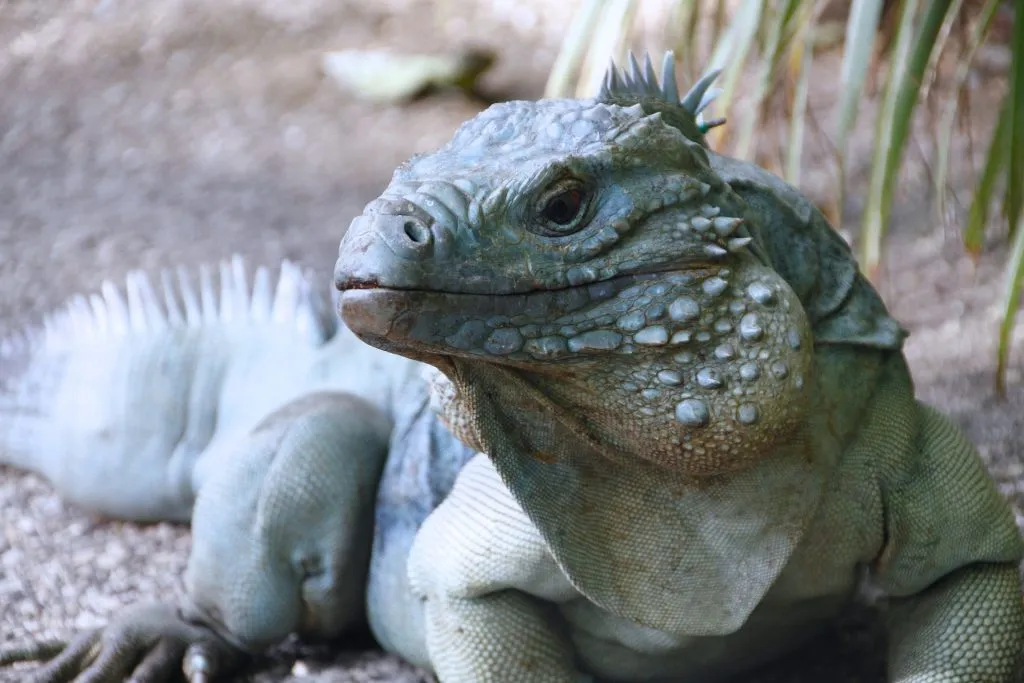
Have you ever met Blue Iguana (also known as Grand Cayman Iguana)? Well, they’re kinda the silent trendsetters among reptiles. Calling the sunlit Cayman Islands home, they sure know how to live the islander’s life. Beyond their iconic blue tint, there’s this mellow aura they radiate that’s absolutely captivating.
Got the Specs?
- Size Matters: They aren’t those mini creatures you can stow in a backpack. Full-grown Blues? They can lengthen up to 4-5 feet. Substantial, yet so sleek.
- Defining Marks: Their elongated frames showcase some refined dorsal spines that trail their back. The dewlap? More discreet than their reptile cousins, but efficient when it comes to cooling or wooing.
- Color Notes: True to their title, they wear blue proudly. Yet, their shade can play tricks depending on their feels and the day’s agenda.
Eats and Daily Grind
Seeming a bit daunting? Surprisingly, they’re all in for a vegetarian diet. They’re fond of a good fruit, flower, and leaf mix. Typical days involve basking under the sun’s glow or hiding out in a cozy shadow, mastering the art of relaxation.
Thinking of Hosting One?
Advantages:
- Their unique hue is bound to stir chats.
- Being herbivore fans means no wriggly feeds to handle.
- Pour in attention and kindness, and they could sync with your rhythm.
Some Caveats:
- They cherish ample spaces, so consider their comfort.
- They might play favorites with certain sunlit spots.
- Their well-being is an ongoing commitment; timely vet check-ins are essential.
Final Whisper
Mulling over adding a Blue Iguana to your squad? It zeroes down to your dedication. They’re undeniably enchanting, but they come with a wishlist. If your environment and dedication align, why not?
Yucatán spiny-tailed iguana

Ever crossed paths with the Yucatán spiny-tailed iguana (Cachryx defensor)? Not your typical superstar, but in the reptile scene, this little dude’s making waves. Tucked away in the Yucatán’s nooks, it’s not their size but their feisty spirit that’s got folks talking.
What’s Their Vibe?
- On the Scale: We ain’t talking Green Iguana size here. These guys are more of the “fun-sized” variety, maxing out around a foot.
- Cool Bits: Tiny but mighty, that’s their mantra. That chunky club tail? It’s like nature’s own Swiss Army knife. And while they don’t sport the typical flashy iguana features, they’ve got a charm that’s hard to miss.
- Color Scene: Ditch the standard green; these buddies go for earthy tones – think browns and grays – perfect for their rock ‘n roll lifestyle.
Munchies and Daily Grind
Looks can be deceptive. They’re all about that veggie life. A little leaf here, a blossom there, and maybe some fruits for dessert. Day in, day out? They’re ground-level celebs, catching some rays on rocky stages and using their tail to slip into backstage hideaways when they’re feeling shy.
Adopting One? The Deets
High Fives:
- Apartment-friendly thanks to their mini size.
- They’re pretty chill with a leafy buffet. No fancy meals needed.
- That unique tail? Instant water-cooler talk.
Some Real Talk:
- They’re fans of rock – literally. You’ll need to recreate their rocky backstage.
- They might play hard-to-get initially. Patience, folks!
- Regular vet gigs are crucial. Got to keep the star in top shape.
And to Wrap…
Pondering on adopting a little rock star from Yucatán? It’s about how much TLC you can jam in. They may not have the paparazzi like other iguanas, but they sure have a stage presence. Got the gear and passion? Rock on!
Jamaican Iguana
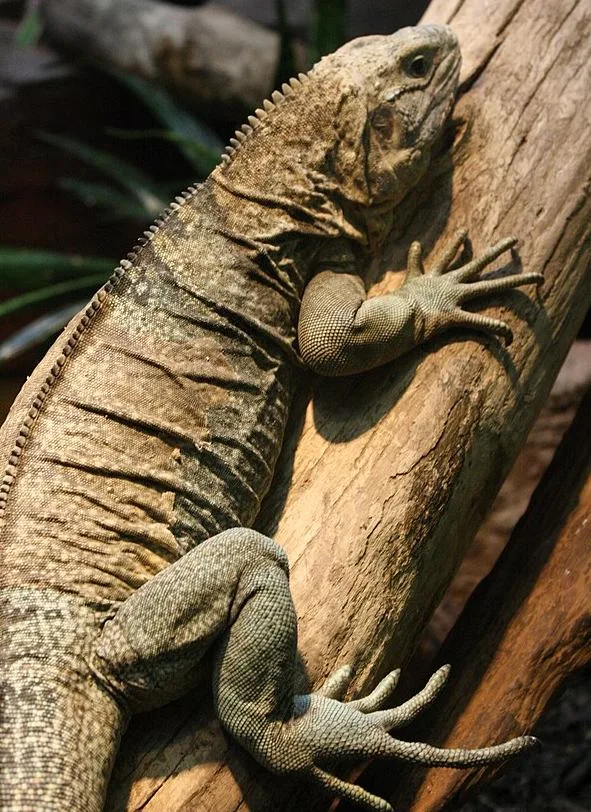
Hey, met the Jamaican Iguana (Cyclura collei) yet? If not, you’re missing out! Straight from Jamaica’s green pockets, this dude’s pretty much the island’s rockstar. Beyond their islander shades, it’s their chill vibes that make them so unforgettable.
What’s Their Vibe?
- Size Check: These aren’t giants, really. Our male pals stretch out to a tidy 17 inches, while the ladies? A tad shorter at around 15 inches.
- Cool Marks: Picture this: a blend of misty grays with hints of blue and green, a dash of olive around the shoulders, and those rad triangular patterns groovin’ down their back.
- Island Shades: These guys flaunt a mix – think mellow grays with pops of island blues, totally giving off those Jamaican beach vibes.
Food and Fun
They might look tough, but greens? That’s their jam! They’re all about munching on the island’s green goodies. And when they’re not munching? Sun-tanning or just lazing under the Jamaican canopy.
Thinking of Hanging with One? Here’s the Lowdown
Plus Points:
- Instant party talker.
- Their love for plants means you won’t be chasing bugs. Phew!
- Shower them with care, and they might just vibe with you.
Heads Up:
- Space lovers, these dudes.
- They can get a tad moody, especially when love’s in the air.
- Regular vet visits? Totally a must.
Wrapping Up
So, considering a Jamaican Iguana as your next chill companion? It’s all about recreating a slice of Jamaica for them. They’re pure island charm, but they’ve got their quirks. If you’re game, go for it!
Utila Spiny-tailed Iguana
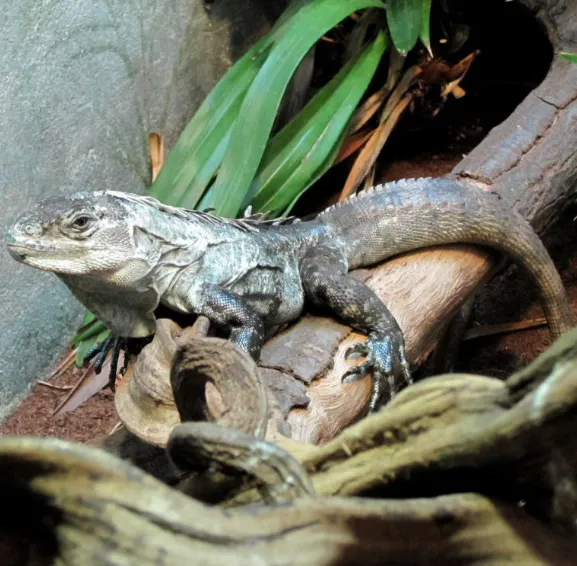
Did you ever hear about the Utila Spiny-tailed Iguana (Ctenosaura bakeri)? If not, allow me to introduce you to the unsung sensation of the reptile universe. From the sun-soaked isles of Utila in Honduras, this unique lizard has slowly but surely been capturing hearts. Their intriguing texture is just the start; wait till you discover their dynamic behaviors!
Ever Wondered About Their Appearance?
- Size Matters: We’re not talking about giants here. They are comfortably medium, and while not exactly pocket-sized, they’re easier to manage. A full-grown one? You’re looking at about 2 to 3 feet.
- Special Traits: Don’t let the size fool you; they’ve got standout spiny tails that are hard to miss. The name isn’t just for show! And while they don’t boast a dewlap like their Green Iguana cousins, their rugged appearance more than makes up for it.
- Color Game: Sporting a variety of earthy tones, they might not be the brightest of the bunch, but they’re certainly one of the most distinctive. Don’t be surprised if their color deepens with age or mood swings.
Diet and Day-to-Day Living: What’s Their Vibe?
They might give you a bit of a tough-guy impression, but their tastes lean towards the herbivore side. Think plants, some fruits, and the occasional flower snack. Lifestyle-wise, these iguanas love their sunbaths and have a thing for rocky terrains and sandy shores.
Considering Making One Your Buddy? A Quick Rundown
Big Wins:
- Their unique looks can be a conversation starter.
- Simplicity is key; greens will keep them happy.
- With a bit of patience, they can warm up to you.
Points to Ponder:
- They need specific habitats to truly thrive.
- Moods swings? Yep, especially during the mating season.
- Their health is paramount; routine vet visits should be on the cards.
A Few Last Words
Thinking about whether the Utila Spiny-tailed Iguana is your next exotic pal? It boils down to dedication. While they’re an intriguing blend of rough and gentle, they come with specific care needs. If you’ve got the commitment and space, why not? But if you’re hesitant, admiring them from a safe, respectful distance might be the way to go.
Cayman Brac Iguana
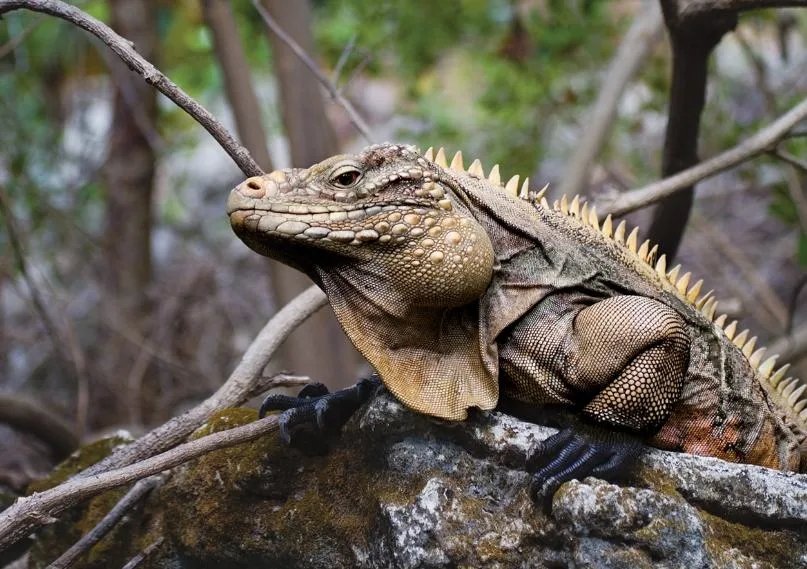
Cayman Brac Iguanas (Cyclura nubila caymanensis) are the hush-hush icons of the reptile scene on the island. With the sun-drenched corners of Cayman Brac as their playground, these critters have won admirers across shores. It’s not just their tropical tint that’s appealing; their undeniable island moxie has its charm too!
What’s Their Vibe?
- Size Up: They aren’t the towering titans of the reptile kingdom, but what they lack in size, they make up in presence. Most of them lounge around within a cozy 2 to 3-foot range.
- The Look: Their stature might be modest, but there’s nothing understated about their look. Patterned to perfection, these iguanas show off textures that echo island vibes. And that neck fringe? It’s multi-purpose – a cooling tool and a dating profile picture, all in one!
- Colors of the Caribbean: They’re not your generic green – think more coastal. Shades of slate, tan, with occasional aqua brushstrokes ensure they fit right into the Caribbean canvas.
Island Routines?
Though they might seem laid-back, they’ve got a diverse palate. These iguanas, while munching on greens, also sample island specialties. Their typical day? Sunbaths, cliff strolls, and some beach time because… why not?
Could You Coexist? Here’s the Gist
Perks:
- Instant talking point – Caribbean iguana, cool right?
- No strict veggie diets; they’re flexible foragers.
- With some patience and the right setting, they might just vibe with you.
Points to Ponder:
- Island folks love their space, so do they.
- They’ve got a hint of island attitude; can be a tad feisty.
- Islander or not, health checks are non-negotiable.
Wrapping it Up
Considering sharing your space with a Cayman Brac Iguana? It boils down to whether you can offer them a sliver of their tropical lifestyle. They’re captivating for sure, but they also come with their set of island quirks. If you’re all in, go for it! But if in doubt, maybe just cheer for them from the sidelines.
Q&A
– Q: Do pet iguanas recognize their owners?
A: Yes, with time and consistent interaction, iguanas can recognize and even show affection towards their owners.
– Q: Do iguanas do well in captivity?
A: With proper care, including a suitable environment, correct diet, and regular health checks, iguanas can thrive in captivity.
– Q: What are the pros and cons of keeping iguanas as house pets?
A: Pros include their unique appearance and potential bond with their owner. Cons might include their demanding habitat requirements and potential aggression during mating seasons.
– Q: Are iguanas considered pests?
A: In some areas, like parts of Florida, where they are not native, they are considered pests due to their impact on local ecosystems.
– Q: What do iguanas typically eat?
A: Iguanas are primarily herbivores, favoring a diet of leaves, fruits, and flowers, but can occasionally eat insects and small animals.
– Q: How do iguanas behave in water and on land?
A: In water, they’re agile swimmers, often walking along the bottom. On land, especially nesting females, might travel considerable distances to find a suitable nesting site.
– Q: Where can you typically find iguanas in the wild?
A: Iguanas are native to various parts of Central and South America and the Caribbean. They prefer habitats with soft bottoms and rich aquatic vegetation.
– Q: How do iguanas reproduce?
A: Female iguanas lay eggs, often between 20 to 40 in a clutch. They search for sandy or loamy soils to nest and can often face threats during this journey.
– Q: How many types of iguanas exist, and where are they primarily found?
A: There are several species of iguanas, such as the green iguana, lesser Antillean iguana, and the Fiji banded iguana. Their distribution ranges from Central and South America to islands in the Caribbean.
– Q: Why are some iguana species endangered?
A: Several factors threaten iguanas, including habitat loss, hunting, and the introduction of non-native species.
– Q: What are the natural predators of iguanas in the wild?
A: Iguanas face threats from various predators, including birds of prey, large fish, snakes, and mammals, depending on their age and habitat.
– Q: How has human interaction influenced the number of predators iguanas face?
A: Human activity has introduced non-native species in certain habitats which have become new predators for iguanas. Additionally, habitat destruction makes iguanas more vulnerable to existing predators.
– Q: Are iguanas native to Mexico?
A: Yes, Mexico is home to several iguana species, with the green iguana being one of the most recognizable.
– Q: Which iguana species are native to North America?
A: North America, primarily in the southern regions and Florida, hosts the green iguana, and they’ve become an invasive species in some parts.
– Q: Are there iguanas native to the Fiji Islands?
A: Yes, the Fiji Islands are home to the Fiji banded iguana, a brightly colored species that’s native to some of the islands of Fiji.
– Q: What is the significance of the Galapagos Islands for iguanas?
A: The Galapagos Islands are home to unique iguana species not found elsewhere, including the Galapagos land iguana and the Galapagos marine iguana.
– Q: How does an iguana’s snout benefit its survival and lifestyle?
A: An iguana’s snout is adapted for its diet and environment. It aids in foraging, biting off chunks of vegetation, and also plays a role in communication and courtship rituals.
– Q: How are conservationists working to protect endangered iguana species in the Galapagos Islands?
A: Conservationists are engaging in habitat restoration, monitoring populations, breeding programs, and raising awareness to protect the unique iguana species of the Galapagos.
– Q: To which family do iguanas belong?
A: Iguanas belong to the family Iguanidae, which includes various species of lizards native to the Americas.
– Q: How is the Galapagos land iguana classified within the Iguanidae family?
A: The Galapagos land iguana, or Conolophus subcristatus, is one of the species within the Iguanidae family and is specifically native to the Galapagos Islands.
– Q: Are iguanas commonly found in South Florida?
A: Yes, South Florida, especially areas like Miami, has seen an influx of green iguanas, which are considered an invasive species in the region.
– Q: Have iguanas made their way to California?
A: While California has its share of exotic pets, it’s not a common natural habitat for iguanas. They are more prolific in states like Florida due to its warmer, more tropical climate.
– Q: What distinguishes land iguanas from other types?
A: Land iguanas are primarily terrestrial, spending most of their time on the ground, while other iguanas might be more arboreal or aquatic. They also have strong legs and claws for digging.
– Q: Why are some iguanas of a bright green color?
A: The bright green color in some iguanas, especially juveniles, helps them blend into their lush, green surroundings in rainforests and vegetative areas, providing camouflage against predators.
– Q: Are all iguanas equipped with sharp teeth?
A: Yes, iguanas have sharp, serrated teeth that help them tear through vegetation, their primary
– Q: Do iguanas typically reside in rainforests?
A: Many iguana species, like the green iguana, thrive in rainforests due to the abundance of
– Q: Are swamps also a suitable habitat for iguanas?
A: Yes, especially for species like the green iguana, swamps offer a wet, tropical environment rich in vegetation and protection from predators.
– Q: Which genus do most common iguanas belong to?
A: The green iguana belongs to the “Iguana” genus, while land iguanas from the Galapagos, for instance, belong to the “Conolophus” genus.
- Enchi Ball Python: A Unique and Stunning Morph of Python regius - March 27, 2025
- Emerald Tree Monitor: The Enigmatic Green Guardian of the Rainforest - March 26, 2025
- The Egyptian Cobra (Naja haje): A Fascinating Serpent - March 25, 2025
